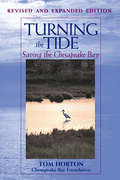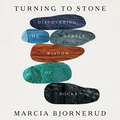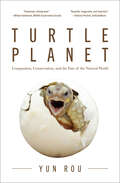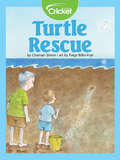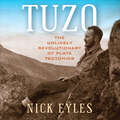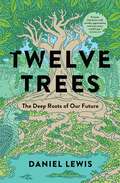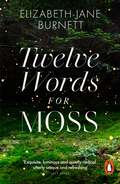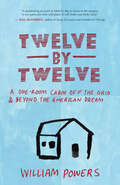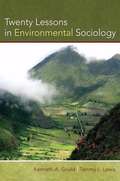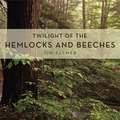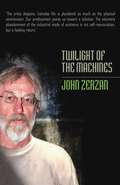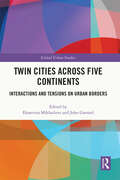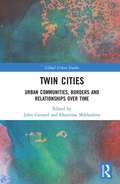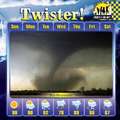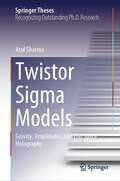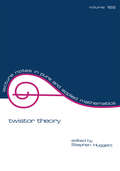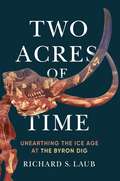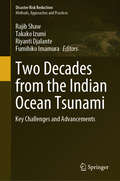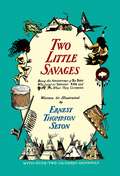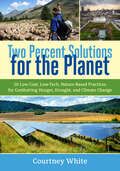- Table View
- List View
Turning the Tide: Saving the Chesapeake Bay
by Tom Horton Chesapeake Bay Foundation William Chesapeake Bay FoundationIn 1991, Island Press published Turning the Tide, a unique and accessible examination of the Chesapeake Bay ecosystem. The book took an indepth look at the Bay's vital signs to gauge the overall health of its entire ecosystem and to assess what had been done and what remained to be done to clean up the Bay. This new edition of Turning the Tide addresses new developments of the past decade and examines the factors that will have the most significant effects on the health of the Bay in the coming years.With new case studies and updated maps, charts, and graphs, the book builds on the analytical power of ten years of experience to offer a new perspective, along with clear, science-based recommendations for the future. For all those who want to know not only how much must be done to save the Bay but what they can do and how they can make a difference, Turning the Tide is an essential source of information.
Turning to Stone
by Marcia Bjornerud'A nuanced celebration of the language of stone' DAVID GEORGE HASKELL'A unique and timeless book' ROBERT HALZENRocks are the record of our creative planet reinventing itself for four billion years. Nothing is ever lost, just transformed. Marcia Bjornerud's life as a geologist has coincided with an extraordinary period of discovery. From an insular girlhood in rural Wisconsin, she found her way to an unlikely career studying mountains in remote parts of the world. As one of few women in her field, she witnessed the shift in our understanding of the Earth, from solid object to an entity in a constant state of transformation. In the most tumultuous times of her own life, a deep understanding of our rocky planet imbued her life with meaning.The lives of rocks are long and complex, spanning billions of years and yet shaping our own human lives in powerful, invisible ways. Sandstone that filters out pathogens creating underground oases in aquifers of clean water. Ecologite is "the chosen rock" whose formation keeps the planet running. Earth is not just a passive backdrop, or a source of resources to be mined, extracted, and carved out. Rocks are full of wisdom, but somewhere along the way many of us have forgotten how to hear it.When we are uncertain about where to find truth, a geocentric worldview reminds us that we are Earthlings, part of a planetary community where we can find wisdom in the most unlikely places.
Turning to Stone
by Marcia BjornerudWINNER OF THE 2025 JOHN BURROUGHS MEDAL FOR DISTINGUISHED NATURAL HISTORY WRITING'Vast and arresting' SPECTATOR'A remarkably human take on the geological world' NEW STATESMANRocks are the record of our creative planet reinventing itself for four billion years. Nothing is ever lost, just transformed.Marcia Bjornerud's life as a geologist has coincided with an extraordinary period of discovery. From an insular girlhood in rural Wisconsin, she found her way to an unlikely career studying mountains in remote parts of the world. As one of few women in her field, she witnessed the shift in our understanding of the Earth, from solid object to an entity in a constant state of transformation. In the most tumultuous times of her own life, a deep understanding of our rocky planet imbued her life with meaning.The lives of rocks are long and complex, spanning billions of years and yet shaping our own human lives in powerful, invisible ways. Sandstone that filters out pathogens creating underground oases in aquifers of clean water. Ecologite is "the chosen rock" whose formation keeps the planet running. Earth is not just a passive backdrop, or a source of resources to be mined, extracted, and carved out. Rocks are full of wisdom, but somewhere along the way many of us have forgotten how to hear it.When we are uncertain about where to find truth, a geocentric worldview reminds us that we are Earthlings, part of a planetary community where we can find wisdom in the most unlikely places.More praise for TURNING TO STONE:'Marcia Bjornerud writes evocatively' COUNTRY LIFE'A nuanced celebration of the language of stone' DAVID GEORGE HASKELL'A unique and timeless book' ROBERT HALZEN
Turning to Stone: Discovering the Subtle Wisdom of Rocks
by Marcia BjornerudWinner of the 2025 John Burroughs Medal for Natural History Writing“A beautiful book—at once intimate and sweeping, informative and moving.” —Elizabeth Kolbert, author of Under a White SkyEarth is vibrantly alive and full of wisdom for those who learn to listen.Earth has been reinventing itself for more than four billion years, keeping a record of its experiments in the form of rocks. Yet most of us live our lives on the planet with no idea of its extraordinary history, unable to interpret the language of the rocks that surround us. Geologist Marcia Bjornerud believes that our lives can be enriched by understanding our heritage on this old and creative planet. Contrary to their reputation, rocks have eventful lives–and they intersect with our own in surprising ways. In Turning to Stone, Bjornerud reveals how rocks are the hidden infrastructure that keep the planet functioning, from sandstone aquifers purifying the water we drink to basalt formations slowly regulating global climate. Bjornerud’s life as a geologist has coincided with an extraordinary period of discovery in the geosciences. From an insular girlhood in rural Wisconsin, she found her way to an unlikely career studying mountains in remote parts of the world and witnessed the emergence of a new understanding of the Earth as an animate system of rock, air, water and life. We are all, most fundamentally, Earthlings and we can find existential meaning and enduring wisdom in stone.
Turtle Planet: Compassion, Conservation, and the Fate of the Natural World
by Yun Rou#1 New Release in Biology of Reptiles & Amphibians and in Taoism - Explore the Bond Between Humans and AnimalsBe a part of it-2020 is Designated “Year of the Turtle” by Zoological and Conservation Organizations.Turtle Planet is a work of philosophical fact and fiction by ordained Daoist Monk Yun Rou. This beautifully written work of thought deeply explores the bond between humans and animals?the wisdom they teach us, the wounds they can heal, and the role we play in their destruction.A Daoist focus on personal cultivation, environmental conservation, and political and social justice. Daoist Monk Yun Rou received his academic education at Yale, Cornell, and the University of California and was ordained a Daoist monk at the Chun Yang (Pure Yang) Taoist Temple in Guangzhou, China. Drawing on fifty years of loving and husbanding turtles, from the car-sized giant Leatherback turtle to the Central Asian tortoise, Monk Yun Rou sounds the alarm of what climate change, global extinction, human intervention, and environmental devastation really mean to their worlds and to ours.See the world through the eyes of turtles. Turtle Planet renders the wonders and suffering of the natural world through the eyes of eighteen exotic turtles. An informational glossary and description of each turtle at the end of the book is provided as a bonus gift to readers.If you have read and learned from books such as H is for Hawk, The Soul of an Octopus, or Ishmael; you will be moved by Turtle Planet, a must for any reader who loves nature, cherishes animals, and celebrates ideas.
Turtle Rescue
by Charnan SimonNana is a turtle trekker! She can help Stella take care of the baby sea turtle they find on the beach.
Tuzo: The Unlikely Revolutionary of Plate Tectonics
by Nick EylesTuzo is the never-before-told story of one of Canada’s most influential scientists and the discovery of plate tectonics, a pivotal development that forever altered how we think of our planet. In 1961, a Canadian geologist named John "Jock" Tuzo Wilson (1908–1993) jettisoned decades of strongly held opposition to theories of moving continents and embraced the idea that they drift across the surface of the Earth. Tuzo tells the fascinating life story of Tuzo Wilson, from his early forays as a teenaged geological assistant working on the remote Canadian Shield in the 1920s to his experiences as a civilian-soldier in the Second World War to his ultimate role as the venerated father of plate tectonics. Illuminating how science is done, this book blends Tuzo’s life story with the development of the theory of plate tectonics, showing along the way how scientific theories are debated, rejected, and accepted. Gorgeously illustrated, Tuzo will appeal to anyone interested in the natural world around them.
Twelve Trees: The Deep Roots of Our Future
by Daniel LewisA compelling global exploration of nature and survival as seen via a dozen species of trees, offering &“extensive insight into the ways in which humans and trees are interconnected&” (BookPage), revealing the challenges facing our planet and how scientists are working urgently to save our forests and our future.The world today is undergoing the most rapid environmental transformation in human history—from climate change to deforestation. Scientists, ethnobotanists, indigenous peoples, and collectives of all kinds are closely studying trees and their biology to understand how and why trees function individually and collectively in the ways they do. In Twelve Trees, Daniel Lewis, curator and historian at one of the world&’s most renowned research libraries, travels the world to learn about these trees in their habitats. Lewis takes us on a sweeping journey to plant breeding labs, botanical gardens, research facilities, deep inside museum collections, to the tops of tall trees, underwater, and around the Earth, journeying into the deserts of the American west and the deep jungles of Peru, to offer a globe-spanning perspective on the crucial impact trees have on our entire planet. When a once-common tree goes extinct in the wild but survives in a botanical garden, what happens next? How can scientists reconstruct lost genomes and habitats? How does a tree store thousands of gallons of water, or offer up perfectly preserved insects from millions of years ago, or root itself in muddy swamps and remain standing? How does a 5,000-year-old tree manage to live, and what can we learn from it? And how can science account for the survival of one species at the expense of others? Twelve Trees &“brims with wonder, appreciation, and even some small hope&” (Booklist) and is an awe-inspiring story of our world, its past, and its future. Note—species include: * The Lost Tree of Easter Island (Sophora toromiro) * The coast redwood (Sequoia sempervirens) * Hymenaea protera [a fossil tree] * The Longleaf pine (Pinus palustris) * East Indian sandalwood (Santanum album) * The Bristlecone pine (Pinus longaeva) * West African ebony (Diospyros crassiflora) * The Tasmanian blue gum eucalyptus (Eucalyptus globulus) * Olive tree (Olea europaea) * Baobab (Adansonia digitata) * the kapok tree (Ceiba pentandra) * The bald cypress (Taxodium distichum)
Twelve Words for Moss: Love, Loss And Moss
by Elizabeth-Jane BurnettSHORTLISTED FOR THE JHALAK PRIZE 2024Shortlisted for the Wainwright Prize 2023 for Nature Writing'Exquisite, luminous and quietly radical . . . utterly unique and refreshing' Lucy JonesWhere nothing grows, moss is the spark that triggers new life. Embarking on a journey though landscape, memory and recovery, Elizabeth-Jane Burnett explores this mysterious, ancient marvel of the plant world, meditating on and renaming her favourite mosses – from Glowflake to Little Loss – and drawing inspiration from place, people and language itself. 'Fascinating, subtle and risk-taking . . . Poetry, descriptive-evocative prose, memory, memoir, natural history and more all drift and mingle in strikingly new ways' Robert Macfarlane
Twelve by Twelve: A One-Room Cabin Off the Grid and Beyond the American Dream
by Bill PowersWhy would a successful American physician choose to live in a twelve-foot-by-twelve-foot cabin without running water or electricity? To find out, writer and activist William Powers visited Dr. Jackie Benton in rural North Carolina. No Name Creek gurgled through Benton’s permaculture farm, and she stroked honeybees’ wings as she shared her wildcrafter philosophy of living on a planet in crisis. Powers, just back from a decade of international aid work, then accepted Benton’s offer to stay at the cabin for a season while she traveled. There, he befriended her eclectic neighbors — organic farmers, biofuel brewers, eco-developers — and discovered a sustainable but imperiled way of life. In these pages, Powers not only explores this small patch of community but draws on his international experiences with other pockets of resistance. This engrossing tale of Powers’s struggle for a meaningful life with a smaller footprint proposes a paradigm shift to an elusive “Soft World” with clues to personal happiness and global healing.
Twentieth Century Land Settlement Schemes (Routledge Research in Historical Geography)
by Roy Jones Alexandre M.A. DinizLand settlement schemes, sponsored by national governments and businesses, such as the Ford Corporation and the Hudson’s Bay Company, took place in locations as diverse as the Canadian Prairies, the Dutch polders, and the Amazonian rainforests. This novel contribution evaluates a diverse range of these initiatives. By 1900, any land that remained available for agricultural settlement was often far from the settlers’ homes and located in challenging physical environments. Over the course of the twentieth century, governments, corporations and frequently desperate individuals sought out new places to settle across the globe from Alberta to Papua New Guinea. This book offers vivid reports of the difficulties faced by many of these settlers, including the experiences of East European Jewish refugees, New Zealand soldier settlers and urban families from Yorkshire. This book considers how and why these settlement schemes succeeded, found other pathways to sustainability or succumbed to failure and even oblivion. In doing so, the book indicates pathways for the achievement of more economically, socially and environmentally sustainable forms of human settlement in marginal areas. This engaging collection will be of interest to individuals in the fields of historical geography, environmental history and development studies.
Twenty Lessons in Environmental Sociology
by Tammy L. Lewis Kenneth A. GouldThe most student-oriented book available for environmental sociology courses, Twenty Lessons in Environmental Sociology introduces undergraduates to the subject in a groundbreaking new way. Instead of compiling articles from professional journals, this innovative reader presents twenty classroom-tested "lessons" from dedicated, experienced teachers. These diverse readings examine key topics in the field, from the social construction of nature to the growing influence of global media on our understanding of the environment. Building this collection on the model of a successful undergraduate classroom experience, coeditors Kenneth A. Gould and Tammy L. Lewis asked the contributors to choose a topic, match it with their favorite class lecture, and construct a lesson to reflect the way they teach it in the classroom. The result is an engaging, innovative, and versatile volume that presents the core ideas of environmental sociology in concise, accessible chapters. Each brief lesson is designed as a stand-alone piece and can be easily adapted into an existing course syllabus. Ideal for any course that looks at the environment from a sociological perspective, Twenty Lessons in Environmental Sociology offers an insightful introduction to this dynamic subject.
Twilight of the Hemlocks and Beeches (Keystone Books)
by Tim PalmerIn this magnificently illustrated book, conservationist and celebrated outdoors photographer Tim Palmer launches us on a revealing journey among the hemlock and beech trees that have for millennia towered over America’s eastern woodlands. The eastern hemlock and North American beech once thrived from Maine to Georgia, casting shade on trout streams, nourishing wildlife large and small, and gracing uncounted valleys, mountainsides, parks, and backyards. These trees now face tragic decimation by exotic insects and pathogens. Palmer’s photos record the splendor of the cherished hemlock and beech in the same way that pictures of iconic, historic buildings commemorate classic landmarks gone the way of the wrecking ball. And yet, as Palmer underscores in his final chapter, the lessons learned as we address the fate of these trees can help us chart a better course for all wooded landscapes in the years ahead. This story of loss, scientific inquiry, and prospective recovery is vital to understanding nature in our time.As an act of artistic preservation, a report on the science vital to the survival of these trees, and a call to action, Twilight of the Hemlocks and Beeches assures a lasting legacy for this irreplaceable forest community. With more than one hundred exquisite full-color photographs, this book is a must-have for outdoor enthusiasts, natural historians, ecologists, and all lovers of nature.
Twilight of the Hemlocks and Beeches (Keystone Books)
by Tim PalmerIn this magnificently illustrated book, conservationist and celebrated outdoors photographer Tim Palmer launches us on a revealing journey among the hemlock and beech trees that have for millennia towered over America’s eastern woodlands. The eastern hemlock and North American beech once thrived from Maine to Georgia, casting shade on trout streams, nourishing wildlife large and small, and gracing uncounted valleys, mountainsides, parks, and backyards. These trees now face tragic decimation by exotic insects and pathogens. Palmer’s photos record the splendor of the cherished hemlock and beech in the same way that pictures of iconic, historic buildings commemorate classic landmarks gone the way of the wrecking ball. And yet, as Palmer underscores in his final chapter, the lessons learned as we address the fate of these trees can help us chart a better course for all wooded landscapes in the years ahead. This story of loss, scientific inquiry, and prospective recovery is vital to understanding nature in our time.As an act of artistic preservation, a report on the science vital to the survival of these trees, and a call to action, Twilight of the Hemlocks and Beeches assures a lasting legacy for this irreplaceable forest community. With more than one hundred exquisite full-color photographs, this book is a must-have for outdoor enthusiasts, natural historians, ecologists, and all lovers of nature.
Twilight of the Machines
by John ZerzanThe mentor of the green anarchist and neo-primitive movements is back with his first book in six years, confronting civilisation, mass society, modernity and technoculture - both the history of its developing crisis and the possibilities for its human and humane solutions. As John Zerzan writes, 'These dire times may yet reveal invigorating new vistas of thought and action. When everything is at stake, all must be confronted and superseded. At this moment, there is the distinct possibility of doing just that. '
Twin Cities across Five Continents: Interactions and Tensions on Urban Borders (Global Urban Studies)
by Mikhailova Ekaterina Garrard JohnThis international collection provides a comprehensive overview of twin cities in different circumstances – from the emergent to the recently amalgamated, on 'soft' and 'hard' borders, with post-colonial heritage, in post-conflict environments and under strain. With examples from Europe, the Middle East, Africa, Asia, South America, North America and the Caribbean, the volume sees twin cities as intense thermometers for developments in the wider urban world globally. It offers interdisciplinary perspectives that bridge history, politics, culture, economy, geography and other fields, applying these lenses to examples of twin cities in remote places. Providing a comparative approach and drawing on a range of methodologies, the book explores where and how twin cities arise; what twin cities can tell us about international borders; and the way in which some twin cities bear the spatial marks of their colonial past. The chapters explore the impact on twin-city relations of contemporary pressures, such as mass migration, the rise of populism, East-West tensions, international crime, surveillance, rebordering trends and epidemiological risks triggered by the COVID-19 pandemic. With case studies across the continents, this volume for the first time extends twin-city debates to fictional imaginings of twin cities. Twin Cities across Five Continents is a valuable resource for researchers in the fields of anthropology, history, geography, urban studies, border studies, international relations and global development as well as for students in these disciplines.
Twin Cities: Urban Communities, Borders and Relationships over Time (Global Urban Studies)
by John Garrard Ekaterina MikhailovaThis dynamic international collection provides a comprehensive overview of twin cities on administrative and international borders across the world. Drawing on contemporary and historical examples, it documents constant and changing features of twinned communities over time. The chapters explore a variety of urban formations including independent cities located side-by-side; cities that have merged over decades or even centuries and those projected to merge; cities partitioned by treaties and cities duplicated in pursuit of better security, intensified trade or both between neighbouring countries. From Europe to Africa, North America to the Middle East, South America to Asia, this book focuses on relationships between cities, citizens and municipal/international borders. A cartographical contents and editorial commentary guide readers through diverse contributions. The authors ask how far cities are changing or remaining constant in the context of conurbanisation, Europeanisation and globalization. The book provides a glimpse into the variety of roles twin cities can play globally: from laboratories of integration and para-diplomatic actors to economic and cultural brokers. This is a valuable, engaging resource for researchers in the fields of geography, urban studies, border studies, international relations and global development. It will be of great use to individuals involved in twin-city initiatives and general readers.
Twister!
by Kris HirschmannDoes that green sky mean a tornado is on its way? Are you wondering What's It Like Out?In this exciting book discover how funnel clouds become tornadoes. Find out how forecasters predict what's coming next. Learn all about the science of weather so you can answer the question, What's It Like Out?
Twistor Sigma Models: Gravity, Amplitudes, and Flat Space Holography (Springer Theses)
by Atul SharmaIn recent decades, twistor theory has grown into an irreplaceable tool for the study of scattering amplitudes in gauge theory and gravity. This book introduces the reader to cutting-edge advances in twistor theory and its applications to general relativity. The problem of graviton scattering in four dimensions is shown to be dual to dramatically simpler computations in a two-dimensional CFT known as a twistor sigma model. Twistor sigma models are the first step toward a holographic description of gravity in asymptotically flat space-times. They underpin the infinitely many asymptotic symmetries of flat space physics discovered in celestial holography, and extend them to exciting new arenas like curved space-times. They also yield intrinsically mathematical results in the field of hyperkähler manifolds. This volume will be of broad interest to students and researchers looking for an accessible entry point into twistor geometry, scattering amplitudes, and celestial holography. It will also provide an invaluable reference for specialists by bringing together results from a host of different disciplines.
Twistor Theory
by AuthorPresents the proceedings of the recently held conference at the University of Plymouth. Papers describe recent work by leading researchers in twistor theory and cover a wide range of subjects, including conformal invariants, integral transforms, Einstein equations, anti-self-dual Riemannian 4-manifolds, deformation theory, 4-dimensional conformal structures, and more.;The book is intended for complex geometers and analysts, theoretical physicists, and graduate students in complex analysis, complex differential geometry, and mathematical physics.
Two Acres of Time: Unearthing the Ice Age at the Byron Dig
by Richard S. LaubIn 1959, what appeared to be the bones of a mastodon were found in a western New York pasture. When researchers began to investigate further in the early 1980s, the site proved to hold far more. Known as the Hiscock Site, it contained an astonishingly rich trove of fossils and artifacts dating from the late Ice Age through the onset of European settlement. For nearly three decades, work at the site—the “Byron Dig”—unearthed new evidence of changing fauna, flora, cultures, and environments over the past 13,000 years.In Two Acres of Time, Richard S. Laub—the principal investigator of the project—tells the story of the Byron Dig. Recounting twenty-nine years of intensive excavation involving more than a thousand participants, he provides a comprehensive account of a working paleontological and archaeological field project and its contributions to our knowledge of the past. Laub explores how understanding of the site evolved through the years, the surprises that came to light along the way, and how contributions from numerous researchers helped achieve a fuller picture of the significance of the findings. The book also shows how people from all walks of life—not only scientists but also volunteers and local small-town residents—worked together to unearth and interpret the site’s contents and to preserve them for future generations. This extensively illustrated book connects life at a scientific excavation project to the grand sweep of long-ago epochs, and is a compelling read and resource for researchers and general readers alike.
Two Decades from the Indian Ocean Tsunami: Key Challenges and Advancements (Disaster Risk Reduction)
by Rajib Shaw Takako Izumi Riyanti Djalante Fumihiko ImamuraThis book presents the advancements in the disaster risk reduction and resilience building in the countries affected by the Indian Ocean Tsunami countries. The book includes a few cross-cutting issues related to governance, technology, and communities, with two major parts: (1) cross-cutting issues and (2) regional and country level experiences. At the threshold of twenty years from Indian Ocean Tsunami, the concept of disaster risk reduction field has evolved significantly in the affected countries as well as around the world. Globally, several mega disasters happened in the last 20 years, and risk landscape has become more complex. In addition, technology, governance, and people’s resilience have gained positive momentum. We had two world conferences on disaster risk reduction, resulting in two global disaster risk reduction frameworks, which aligned with development frameworks as well as climate change agreements. COVID-19 and post COVID risk landscape has brought the new dimension of compound and complex disasters and need for all hazards’ approach.
Two Little Savages: Being the Adventures of Two Boys Who Lived as Indians and What They Learned
by Ernest Thompson SetonThis is one of the great classics of nature and boyhood by one of America's foremost nature experts. It presents a vast range of woodlore in the most palatable of forms, a genuinely delightful story. It will provide many hours of good reading for any child who likes the out-of-doors, and will teach him or her many interesting facts of nature, as well as a number of practical skills. It will be sure to awaken an interest in the outdoor world in any youngster who has not yet discovered the fascination of nature.The story concerns two farm boys who build a teepee in the woods and persuade the grownups to let them live in it for a month. During that time they learn to prepare their own food, build a fire without matches, use an axe expertly, make a bed out of boughs; they learn how to "smudge" mosquitoes, how to get clear water from a muddy pond, how to build a dam, how to know the stars, how to find their way when they get lost; how to tell the direction of the wind, blaze a trail, distinguish animal tracks, protect themselves from wild animals; how to use Indian signals, make moccasins, bows and arrows, Indian drums and war bonnets; how to know the trees and plants, and how to make dyes from plants and herbs. They learn all about the habits of various birds and animals, how they get their food, who their enemies are and how they protect themselves from them.Most of this information is not generally available in books, and could be gained otherwise only by years of life and experience in suitable surroundings. Yet Mr. Thompson Seton explains it so vividly and fully, with so many clear, marginal illustrations through the book, that the reader will finish "Two Little Savages" with an enviable knowledge of trees, plants, wild-life, woodlore, Indian crafts and arts, and survival information for the wilds. All of this is presented through a lively narrative that has as its heroes two real boys, typically curious about everything in the world around them, eager to outdo each other in every kind of endeavor. The exciting adventures that befall them during their stay in the woods are just the sort of thing that will keep a young reader enthralled and will stimulate his or her imagination at every turn.
Two Percent Solutions for the Planet: 50 Low-Cost, Low-Tech, Nature-Based Practices for Combatting Hunger, Drought, and Climate Change
by Courtney WhiteTwo Percent Solutions for the Planet profiles fifty innovative practices that soak up carbon dioxide in soils, reduce energy use, sustainably intensify food production, and increase water quality. The &“two percent&” refers to: the amount of new carbon in the soil needed to reap a wide variety of ecological and economic benefits; the percentage of the nation&’s population who are farmers and ranchers; and the low financial cost (in terms of GDP) needed to get this work done.As White explained in Grass, Soil, Hope, a highly efficient carbon cycle captures, stores, releases, and recaptures biochemical energy, mitigating climate change, increasing water storage capacities in soil, and making green plants grow. Best of all, we don&’t have to invent anything new—a wide variety of innovative ideas and methods that put carbon back into the soil have been field-tested and proven to be practical and profitable. They&’re mostly low-tech, too, relying on natural resources such as sunlight, green plants, animals, compost, beavers, creeks, and more.In Two Percent Solutions for the Planet, White expands what he calls the &“regenerative toolbox,&” to include holistic grazing, edible forests, biochar, weed-eating livestock, food co-ops, keyline plowing, restoration agriculture, bioenergy, aquaponics, animal power, Farm Hack, bees, bears, wildlife corridors, rainwater harvesting, native seeds, and various other projects from across the United States, as well as in Canada, Europe, and Australia. These short, engaging success stories will help readers connect the dots between diverse, exciting, and pragmatic practices, and inspire them to dig deeper into each individual story and concept, energized by the news that solutions do exist.
